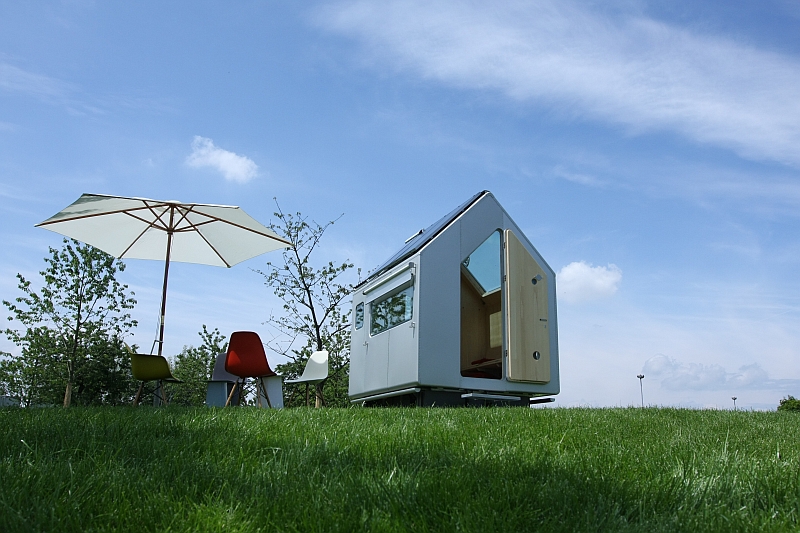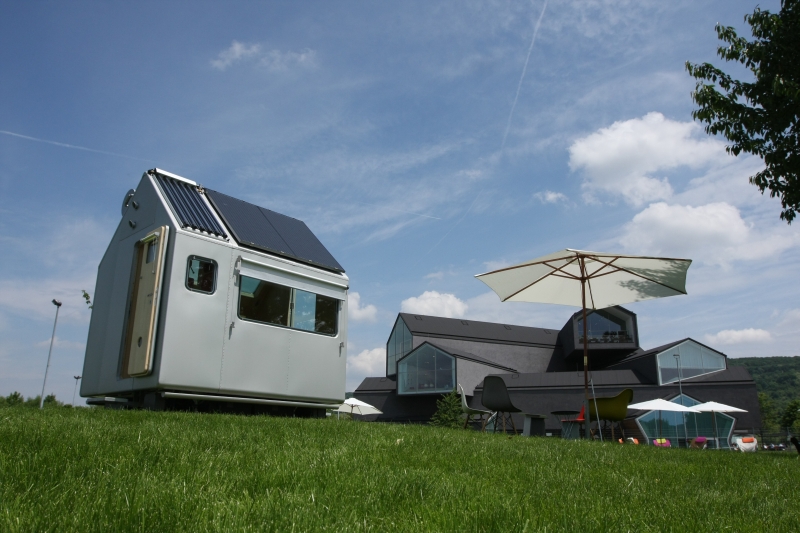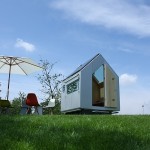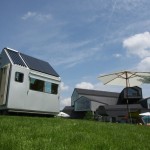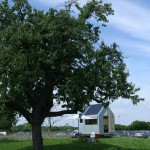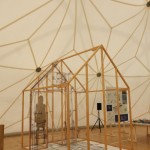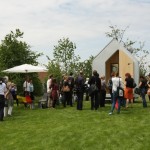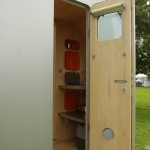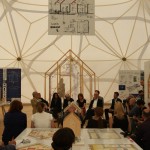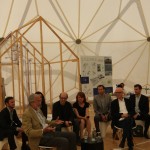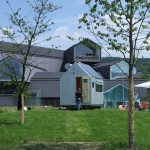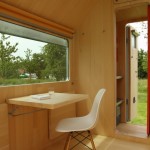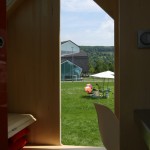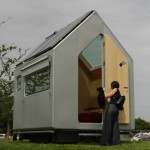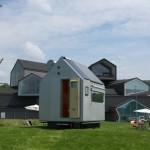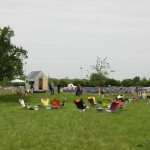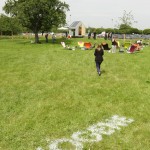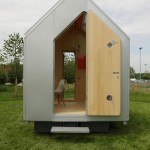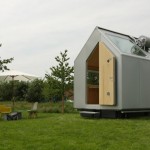Diogene by Renzo Piano Building Workshop and Vitra
“You can’t lose ideas in a small space” with this simple piece of almost Confucian wisdom Italian architect Renzo Piano explains part the deeper philosophy behind Diogene, his collaboration with Vitra. And the latest object on the Vitra Campus.
Following quickly on from the public presentation of the SANAA Factory Building – unquestionably the biggest building on the Vitra Campus – Diogene is equally unquestionably the smallest.
In fact, if our maths are correct you could fit around 2,600 Diogenes inside one SANAA.
By his own admission one of Renzo Piano’s longest held dreams has been to build a 2 metre by 2 metre house. That may appear a wish at stark odds with his more famous works, including, for example, the Centre Pompidou Paris, Kansai Airport in Japan or most recently the Shard in London. But less famously Renzo Piano has also designed seven boats, a couple of cars and recently designed cells for the nuns at the Community of the Poor Claire Convent in Ronchamp, France.
The idea for Diogene began some ten years ago as a self-initiated concept-work-in-progress. In 2009 the Italian design and architecture magazine Abitare presented the project with an appeal from Renzo Piano that he was looking for a partner.
Intrigued by this novel “Lonely Hearts” advert, Vitra CEO Rolf Fehlbaum answered the call and since 2010 Vitra and the Renzo Piano Building Workshop (RPBW) have co-developed the project.
Constructed from a wood core with an aluminium shell Diogenes is a passive, energy neutral house that offers comfortable accommodation for one, or passable accommodation for two.
And we use the word “house” deliberately because for both Renzo Piano and Rolf Fehlbaum it is and was important that the object is a house: not a container and not a caravan. But a house.
Which is why it has a pointy roof. Which is also why the VitraHaus has a pointy roof. It’s a house.
Kitted out with solar panels for generating electricity and heating water, Diogene also collects rainwater and comes equipped with a compost toilet. As such it is self-supplying and self-sufficient. All it takes from its local environment is a few square metres of ground. A shower and small kitchen allow for the more pleasant things in life, and the living space is equipped with a three part desk that collapses flat against the wall and a sitting bench-cum-bed. There is also a heating option, but if you forgive us, we’ve lost the details.
And although not mobile per se Diogene has been designed so that it can be transported in its constructed form.
The references in the work are manifold, for us the most obvious being Le Corbusier’s Cabonon or the many experimental constructions of Jean Prouve, one of which can currently be marvelled at Design Basel. And in terms of Jean Prouve, the design of the roof lamp in the living space is an unashamed nod to Renzo Piano’s former teacher. Which we like. A lot.
At the moment Diogene is a prototype, however Rolf Fehlbaum sounds determined to develop it into a fully fledged product. The plan at the moment appears to be to eventually offer Diogene in a range of models from a very basic up to what could be considered a luxury. And cautious first price calculations have clearly been made, calculations that would price the “standard” Diogene on a par with a mid-lower priced family car.
A fact that of course, finally, raises the unavoidable question as to who actually needs such an object?
The short answer is of course no one.
But then no one really needs a mid-lower priced family car. Or a holiday cottage in the Algarve. Or a portable telephone that takes pictures and plays music.
But given that our modern consumer culture and our innate desire to better our situation aren’t going to disappear anytime soon, it is important that those things we do have and do consume are socially and ethically defensible and that their impact on our world is as slight as possible.
And to achieve that we need research that tackles many of the questions contained in the very simple form of Diogene
So let’s rephrase the question and ask, for whom could Diogene be useful and sensible?
At the launch there was regular talk of using it as emergency accommodation. For that it is in our opinion too complex, too small and too house shaped. Simple containers provide, and will continue to provide, a quicker, more flexible, easier transportable and storable solution.
However as low-maintenance, limited impact, permanent accommodation in a wilderness area, forest or the like, why not? Either as a structure intended to provide emergency accommodation for those who find themselves unwittingly there or as part of a network of huts for staff. We certainly know one vineyard in southern England that would greatly benefit from the use such a structure. Yes you could build wooden huts. But the central element with Diogene is the technology. And you don’t have all that in a wooden hut.
The other major theme discussed was Diogene as a personal place of retreat. And in such a context obvious uses could include as a hideaway in your garden, as a small weekend house on a lake shore/river bank for the keen angler, or as a dream construction for extreme shed-workers who like to sleep near their place of creativity.
Or alternatively we can well imagine its use en mass for a minimal impact, high-end “outdoor” hostel. And certainly looking at the prices some operators charge for “pods” at European music festivals, Diogene could have a future at Glastonbury, Melt, Roskilde et al.
Diogene is ca 3 m x 2.5 m, and as such Renzo Piano hasn’t, yet, achieved his dream. But then the important fact about Diogene isn’t its size, but its construction principle, the technology that has been built into it, its forward thinking attitude and for all what it teaches about the possibilities for building design in the future.
Diogene will never become Vitra’s biggest selling product. But as a small space being exploited to explore big ideas, it is certainly one of the more adventurous, one of the more interesting and potentially heralds the opening of the next chapter in the Vitra story.
We’ll keep you updated.
- Can Sofa by Ronan et Erwan Bouroullec for HAY (original photo from The Historia Supellexalis)
- Diogene by Renzo Piano Building Workshop and Vitra
- Big Vitra House. Little Vitra House.
- Diogene by Renzo Piano Building Workshop and Vitra.
- Diogene by Renzo Piano Building Workshop and Vitra. The wood skeleton.
- Airstream is a caravan. Diogene a house….. It’s an important difference.
- For their summer party Vitra clearly booked far too small a venue…..
- Diogene by Renzo Piano Building Workshop and Vitra. The Kitchen.
- Press conference with Renzo Piano and Rolf Fehlbaum.
- Press conference with Renzo Piano and Rolf Fehlbaum.
- Diogene by Renzo Piano Building Workshop and Vitra.
- Diogene by Renzo Piano Building Workshop and Vitra. Interior.
- Diogene by Renzo Piano Building Workshop and Vitra.
- Diogene by Renzo Piano Building Workshop and Vitra.
- Diogene by Renzo Piano Building Workshop and Vitra.
- Diogene by Renzo Piano Building Workshop and Vitra.
- Diogene by Renzo Piano Building Workshop and Vitra.
- Diogene by Renzo Piano Building Workshop and Vitra.
- Diogene by Renzo Piano Building Workshop and Vitra.
Tagged with: Diogene, Renzo Piano, Vitra
